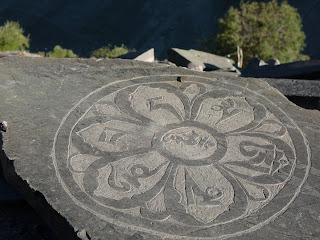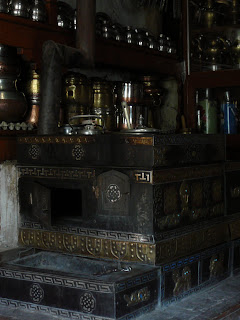Two words:
Dog rough.
A few years back I gave up picking up hitchhikers and since I was no longer doing it, I assumed others had abandoned the practice as well. This, I was to find out, has not gone away in Ladakh. At quarter till midnight our mini-bus driver pulled the side of the road and took on an additional two passengers -- bleary-eyed men with oddly-shaped ski masks. That this was done just outside a military checkpoint made it all the more surreal.
The road, well, let's revel in hyperbole for a moment. It ranges from bad-but-not-disastrous to holy-crap-we're driving-in-dry-riverbed to aiiiee-we're-going-off-the-roooo-oh-it's-a-"shortcut."
At a bit past 3 a.m. or so we surmounted Tanglang La Pass which, at 5,360 meters (17,585 feet), is the second highest motorable pass in the world, a feat that was marked with little more than an unceremonious beep of the horn. The hitchhiker who was now in deep sleep on the floor beneath my seat appeared less than impressed. (Elizabeth, too, appeared to be sleeping -- or else in silent, eyes-closed avoidance of the state of the road.) Had I been handed a snow shovel, a pound of hashish, or a chicken to carry, I wouldn't have blinked.
At about 5 a.m. we pulled into a large, dirty parking lot with loads of diesel buses and cargo trucks idling as drivers stepped inside dusty tents for chai and paan, a vile Indian chewing "treat" that's similar to Skoal. Fires started up in trashcans and the sun began to rise on many miles of icy moonscape. (And Elizabeth realized that the one advantage of darkness -- for her and the other two women on the bus, any shadowy area was a bathroom -- had now disappeared....)
Having neglected to pack a sleeping bag, I took a tip from Douglas Adams' intergalactic vagabond Ford Prefect and whipped out my pack towel. At a scant one ounce it provided a slim measure of protection from the arctic winds that blew in with paan spittle from the front window (though Elizabeth blocked most of that). My friend on the floor looked to have the right idea.
Here it's worth noting that this leg of travel was an act of choice. Like the fellas in the parking lot of Say Anything, we were choosing it. We had, of course, been warned. Tales abound of hippie-trail backpackers, road warriors, and gung-ho Aussies brought to their knees by bum-numbing seats, invisible parasites, and the menacing tone lent to 'no toilet 100 km.' The lyrics to Sonic Youth's "Tom Violence" played like an incessant drone: "I left home for experience..." Choice makes fools of us all.
But on the real, daybreak transformed both the terrain and our state of mind. Deep into the
More Plains I was awestruck by the change in color. Dull browns had given way to pleasant yellow ground cover, deep gorges cut by icy rivers, and lengthy expanses that would find parallels in the American Southwest (but here they were anywhere from 10,000 to 15,000 feet higher). Here, there truly can be solace in open spaces.
A few more hours on and we pulled over amid massive snow-covered peaks and a roadside dhaba -- food stand/tent cafe/low cost bivouac -- that served a fabulous breakfast of chapati topped with plain omelette and mango pickle for 40Rs. Plus tea, of course. And for the adventurous, Old Monk rum, but Elizabeth told me I didn't couldn't have it because many curves lay ahead and she had the window seat. Then we found some taller rocks on the vast plain for our bathroom stops, and climbed back on the bus.
After rerouting off an unstable bridge and into what seemed like a glacial moraine we passed through
Darcha which boasted a mesmerizing collection of high-terraced fields, waterfalls, and intrepid sheep. Only once did I count a vehicle that'd given way to the brutal tug of gravity, its carcass hardly identifiable. I thought it better not to point it out to the others nor dwell to long on it. Instead I chose to invest trust in our driver, who had not once taken the opportunity to text friends back home or argue with military road-hogs. (Elizabeth says she saw him texting, but she's just bitter about that paan-spit.)
By 5 p.m. we were cresting the rise at
Rohtang Pass, whose name means, according to our guidebook, "piles of dead bodies." We experienced it less gruesomely as the site of herds of Indian honeymooners, saris set aloft by a chilly mountain breeze. From here it's a scant 51 kilometers to Manali but in the mountains, no one can ever quite go as the crow flies. We were caught in a traffic jam that extended deep into the foggy abyss below, but we distracted ourselves watching para-gliders launching nearby as a troop of men set up impromptu roadside grills and served corn on the cob. You've got to admire the DIY spirit that this nation of one billion inspires.
At 6:30 p.m., a precise 18 hours after setting off from Leh, we arrived in Manali, a town we are fast discovering is a favorite among Israeli youth, fresh off compulsory national service, in search of cheap drugs and down-at-heel digs.
In all, the ride proved itself memorable in every sense. My clothes were filthy with pyrite dust and my knees continue to ache even after arriving, but I've never been gone as high into the mountains, let alone by car, and the views were some of the most extraordinary either of us has ever seen. This was also one of the few times I've been so ready to sleep I'd pay any amount no matter what for a room, but lucky for us, the eats and sheets come cheap in Manali and our senses are returning to normal.
And now it's time to go watch the local production of the Ramayana...



































